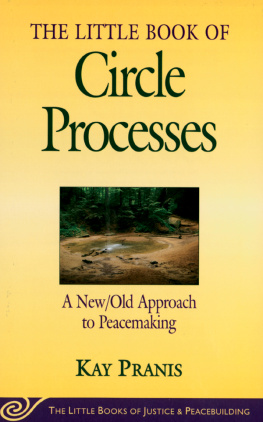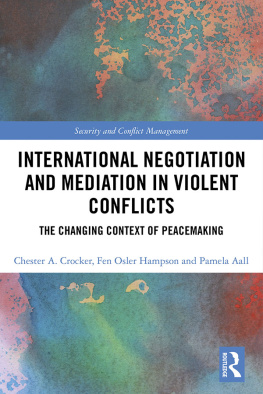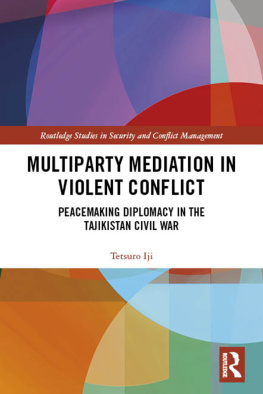Light on Peacemaking
Light on Peacemaking
A Guide to Appropriate Dispute Resolution and Mediating Family Conflict
Thomas DiGrazia

Light on Peacemaking: A Guide to Appropriate Dispute Resolution and Mediating Family Conflict
Copyright Business Expert Press, LLC, 2016.
All rights reserved. No part of this publication may be reproduced, stored in a retrieval system, or transmitted in any form or by any meanselectronic, mechanical, photocopy, recording, or any other except for brief quotations, not to exceed 400 words, without the prior permission of the publisher.
First published in 2016 by
Business Expert Press, LLC
222 East 46th Street, New York, NY 10017
www.businessexpertpress.com
ISBN-13: 978-1-63157-311-8 (paperback)
ISBN-13: 978-1-63157-312-5 (e-book)
Business Expert Press Business Law Collection
Collection ISSN: 2333-6722 (print)
Collection ISSN: 2333-6730 (electronic)
Cover and interior design by Exeter Premedia Services Private Ltd.,
Chennai, India
First edition: 2016
10 9 8 7 6 5 4 3 2 1
Printed in the United States of America.
To All My Relations, to those, both nearby, and in distant galaxies,
mi profondo grazie e amore for all your support and gifts.
You well know who you are, especially my LuLu.
Aloha Tom.
Abstract
Many books have been written about the practice of peacemaking , and few, if any, contribute to the non-violent, spiritual side of this ancient science, discipline, practice and art form. This book speaks to that lack and explores the spiritual, non-violent element in peacemaking as it applies to appropriate dispute resolution and mediating family law disputes.
Universities will find the book helpful as a textbook in their peacemaking and mediation degree and certificate programs. This book is intended for the professional peacemaker , mediator, lawyer, law student, conciliator, and dispute neutral. Everyday people wishing to improve their own communication skills and strengthen their primary relationships will profit greatly from this book. Those in the family law field, will find much benefit from the peacemaking processes, family counseling psychology, Eastern philosophy and Yoga, collected wisdom, experience and practice pointers presented in Light on Peacemaking .
Mental health family practitioners, who are often called upon to act as default, if not, formal mediators and neutrals, will find useful the mediation and peacemaking experiences, techniques and literature related here. Light on Peacemaking also offers the Yoga practitioner a very practical avenue, through example in the legal field, for engaging in seva or service to humanity.
Keywords
ADR processes, adversarial, alimony, alternative dispute resolution, appropriate dispute resolution, B.K.S. Iyengar, brain science, child support, children, collaborative law, conflict, conscious uncoupling, counseling, courts, difficult conversations, divorce, Eastern philosophy, educated divorce, evaluative, facilitative, family counseling, family court, family law, interdisciplinary team, J. Krishnamurti, law, law student, lawyers, legal system, litigation, marital dissolution, mediation, mediation participants, mediation skills and techniques, mediator, mental health professional, mindfulness, Native Americans, negotiations, neutral, nonviolence, peacemaker, peacemaking, peacemaking algorithm, post-traumatic stress disorder (PTSD), psychologists, psychology, seva (service to humanity) and ahimsa (do no harm), spiritual, students, seva, transformation, violence, yoga, Yoga Sutra
Contents
I.
Although many books have been written about the practice of peacemaking, few, if any, deal with the nonviolent, spiritual side of this ancient science, discipline, practice, and art form. This book will speak about this and explore the spiritual, nonviolent element in peacemaking as it applies to mediating family law disputes.
As a point of clarification, throughout the course of compiling this book, I have used the terms peacemaker and mediator interchangeably, in spite of the fact that as a general rule, I prefer the term peacemaker to that of mediator. I do, however, continue to use the term mediator in certain contexts, as at this point, it remains the most widely recognized term associated with this type of activity within the realm of family law. The same can be said for the related terms, mediation , mediation process , and mediation participants .
I also prefer to use the terms, peacemaking process and peacemaking participants ; as in my opinion, these designations offer a wider framework for assisting others to resolve conflict and to move on with their lives. The word Peacemaking more comfortably allows for the recognition and integration of skills used for thousands of years by indigenous and ancient cultures in the resolution of conflicted relationships. It will quickly become apparent to the reader that the field of psychology, along with Eastern philosophies and disciplines, in particular that of the practice of Yoga, are keys to the processes involved in Peacemaking . As such, they are to be seen as the ground upon which modern peacemaking and the mediation techniques outlined within this guide are based. A key point here is that Peacemaking is a much more inclusive and creative approach to resolving such human dilemmas as quarrels, disagreements, discord, tension, controversy, opposition, personality struggles, and disputes, than any form of litigation or other adversarial technique.
This book draws upon my more than four decades of experience as a lawyer and peacemaker , and, in particular, relies heavily on the accumulation of a broad range of experience gathered during the last near 30 years in Hawaii, as a practitioner of general law and as director of the Mediation CenterWindward Oahu . The interdisciplinary program, which I created while there, Educated Divorce, I consider being the hallmark of my professional mediation career, and been adopted as the framework for the Centers focus on family law mediation . This useful interdisciplinary tool will be explained in detail in later chapters. The Mediation Center is a direct descendent of its namesake in Santa Barbara, California, where up until the mid-1980s, I received my professional peacemaking training at the knee of my mentor and the Centers founder, Gail Rappaport. To this training, I added important understandings and skills picked up throughout my early childhood in the dysfunctional, conflict-plagued world of Little Italy, in lower New York City, during the 1950s. In addition, I was honored and lucky to have the chance to spend time observing and working with Native American community peacemaking practices, between 1970 and 1985, which furthered my passionate interest in resolving conflicts without adversarial violence, antagonism, or disputant destruction.
This background experience in professional peacemaking has been much enriched by my years as an adjunct professor at Hawaii Pacific University (HPU) in Honolulu, where I taught a course in Mediation and Conflict between 2010 and 2014. My professorial duties in the graduate Certificate Program in Mediation and Conflict at HPU caused me to reflect deeply on my professional practice in order to more effectively impart the benefits gained by this experience to my students, many of who come here to study from a host of countries around the world. The outline for this book, to a large degree, is derived from my extensive class lecture notes and the positive feedback and encouragement of my many American and international students.
Next page











